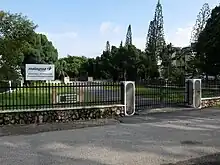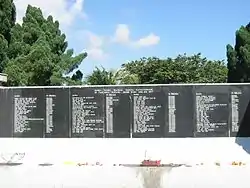Malaysian Airline System Flight 653
Malaysian Airline System Flight 653 (MH653) was a scheduled domestic flight from Penang to Kuala Lumpur in Malaysia, operated by Malaysian Airline System (MAS). On the evening of 4 December 1977, the Boeing 737-200 aircraft flying the service crashed at Tanjung Kupang, Johor, Malaysia, while purportedly being diverted by hijackers to Singapore.[1] It was the first fatal air crash for Malaysia Airlines[2][3] (as the airline is now known), with all 93 passengers and 7 crew killed.[4][5] It is also the deadliest aviation disaster to occur on Malaysian soil.[6] The flight was apparently hijacked as soon as it reached cruise altitude. The circumstances in which the hijacking and subsequent crash occurred remain unsolved.
 A Malaysian Airline System Boeing 737-200 registered as 9M-MBH, similar to the aircraft involved in the incident. | |
| Hijacking | |
|---|---|
| Date | 4 December 1977 |
| Summary | Hijacking |
| Site | Tanjung Kupang, Johor, Malaysia 1.3887°N 103.5314°E |
| Aircraft | |
| Aircraft type | Boeing 737-2H6 |
| Operator | Malaysian Airline System |
| Registration | 9M-MBD |
| Flight origin | Penang International Airport |
| Last stopover | Sultan Abdul Aziz Shah Airport |
| Destination | Singapore Int'l Airport (Paya Lebar) |
| Passengers | 93 |
| Crew | 7 |
| Fatalities | 100(all) |
| Survivors | 0 |
Aircraft
The aircraft involved was a Boeing 737-2H6[lower-alpha 1] registered as 9M-MBD. It had been delivered new to MAS in September 1972 with registration 9M-AQO.[6]
Sequence of events
Flight 653 departed from Runway 22 at Penang International Airport at exactly 19:21 for Kuala Lumpur's Subang Airport (now known as Sultan Abdul Aziz Shah Airport).[7]
Captain GK Ganjoor and First Officer Karamuzaman Jali were making landing preparations at 19:54, while at an altitude of 4,000 feet (1,200 m) over Batu Arang and descending toward Runway 33 at Subang Airport, when the crew reported to Subang Tower that an "unidentified hijacker" was on board, after someone knocked on the cockpit doors.[8] Subsequently, the pilots were forced to cut off all communications by a group of hijackers who suddenly barged into the cockpit. The tower immediately notified the authorities, who made emergency preparations at the airport.[9]
A few minutes later, the crew radioed: "We're now proceeding to Singapore. Good night."[10] In the last few minutes of the tapes from the cockpit voice recorder, investigators heard conversation between the pilots and the hijackers about how the aircraft would run out of fuel before it could make it to Singapore, followed by a series of gunshots. They concluded that both the pilot and co-pilot were fatally shot by the hijacker, which left the plane "professionally uncontrolled".[11] At 20:15, all communication with the aircraft was lost. At 20:36, the residents of Kampong Ladang, Tanjung Kupang in Johor reported hearing explosions and seeing burning wreckage in a swamp. The wreckage was later identified as the aircraft; it had hit the ground at a near-vertical angle at a very high speed. There were no survivors.[4]
Investigation and aftermath

The full circumstances of the hijacking and crash were never solved. However, airport officials at Kuala Lumpur said pilots had radioed that members of the Japanese Red Army had hijacked the plane.[4][12] In 1996, while reporting about the hijacking and crash of Ethiopian Airlines Flight 961, CNN reporters wrote that the hijackers were in fact identified as Red Army members,[13] but this has not been confirmed.[14] All recovered remains were x-rayed in an attempt to discover evidence of a projectile or weapon, but no such evidence was ever found. The remains of the victims were interred in a mass burial.[15]
After the incident, the Aviation Security Unit of the Airport Standard Division of the Department of Civil Aviation Malaysia was established.[16]
Passengers and crew

Passengers included the Malaysian Agricultural Minister, Dato' Ali Haji Ahmad; Public Works Department Head, Dato' Mahfuz Khalid; and Cuban Ambassador to Japan, Mario García Incháustegui.[1][17][18]
Among the flight's cabin crew perished in the crash is Onn Jaafar, nephew of then Malaysian Prime Minister, Hussein Onn.[19]
| Nationality | Passengers | Crew | Total |
|---|---|---|---|
| 67 | 6 | 73 | |
| 5 | 0 | 5 | |
| 4 | 0 | 4 | |
| 3 | 0 | 3 | |
| 2 | 1 | 3 | |
| 3 | 0 | 3 | |
| 2 | 0 | 2 | |
| 1 | 0 | 1 | |
| 1 | 0 | 1 | |
| 1 | 0 | 1 | |
| 1 | 0 | 1 | |
| 1 | 0 | 1 | |
| 1 | 0 | 1 | |
| 1 | 0 | 1 | |
| Total (14 Nationalities) | 93 | 7 | 100 |
See also
Notes
- The aircraft was a Boeing 737-200 model; Boeing assigns a unique customer code for each company that buys one of its aircraft, which is applied as a suffix to the model number at the time the aircraft is built. The code for Malaysian Airline System (now Malaysia Airlines) is "H6", hence "737-2H6".
References
- "A hijacked Malaysian airlines jet with 100 persons aboard exploded and crashed Sunday night". Associated Press. 4 December 1977.
- "Malaysia Airlines flight crashes with 50 on board". Agence France Presse. 15 September 1995.
- "Worst MAS plane crash occurred in 1977". New Straits Times. 15 September 1995. p. 4.
- "All 100 Aboard Killed in Crash of Hijacked Malaysian Airliner". Toledo Blade. Johore Baharu. Associated Press. 4 December 1977. Retrieved 22 July 2014 – via Google News.
- "Hijacked Jet Crashes in Malaysia; All 100 Aboard Are Feared Dead". The New York Times. Associated Press. 5 December 1977. ISSN 0362-4331. Retrieved 12 March 2021.
- Ranter, Harro. "Hijacking description, Boeing 737-2H6 9M-MBD". Aviation Safety Network. Flight Safety Foundation. Retrieved 9 March 2014.
- "328 killed in nine incidents". New Straits Times. 1 September 1996. p. 4.
- Taylor, Phil (14 April 2014). "Hijacked airman's family still suffering 37 years after crash". NZ Herald. Retrieved 12 March 2021.
- "Revisited after 36 years: Malaysia Airlines MH653". Retrieved 1 July 2019.
- Dennis, William (4 January 2000). "Asian Rebound Boosts Startups, But Safely Remains A Concert [sic]". Aviation Daily.
- Boykoff, Pamela; Mohsin, Saima (28 March 2014). "Mystery of Malaysia Airlines Flight 370 surfaces pain of 1977 tragedy". CNN. Retrieved 28 March 2014.
- "Investigators Searching Crash Site For Clues About Hijackers". Observer-Reporter. Associated Press. 5 December 1977. Retrieved 12 March 2021 – via Google News.
- "Ethiopia mourns crash victims". CNN. 25 November 1996. Archived from the original on 23 December 2004. Retrieved 22 July 2014.
The deadliest previous hijacking took place in 1977, when terrorists identified as the Japanese Red Army took over a Malaysian airlines jet traveling to Kuala Lumpur.
- Dempsey, Kylan (21 October 2020). "Who hijacked Malaysia Airlines 653? Revisiting the mystery 43 years on". Southeast Asia Globe. Retrieved 13 October 2021.
- "Mass burial planned for unidentified victims". New Straits Times. 18 September 1995. p. 7.
- "Aviation Security". www.dca.gov.my. Civil Aviation Authority of Malaysia. Archived from the original on 27 June 2020. Retrieved 16 September 2016.
- "Memorial tells a sad tale of neglect". Business Times. 15 January 2000.
- Ramendran, Charles (12 March 2021). "Who hijacked Flight MH653?". The Sun. Retrieved 12 March 2021.
- "Common burial for air crash victims". The Straits Times. eresources.nlb.gov.sg. 8 December 1977. Retrieved 23 December 2022.

